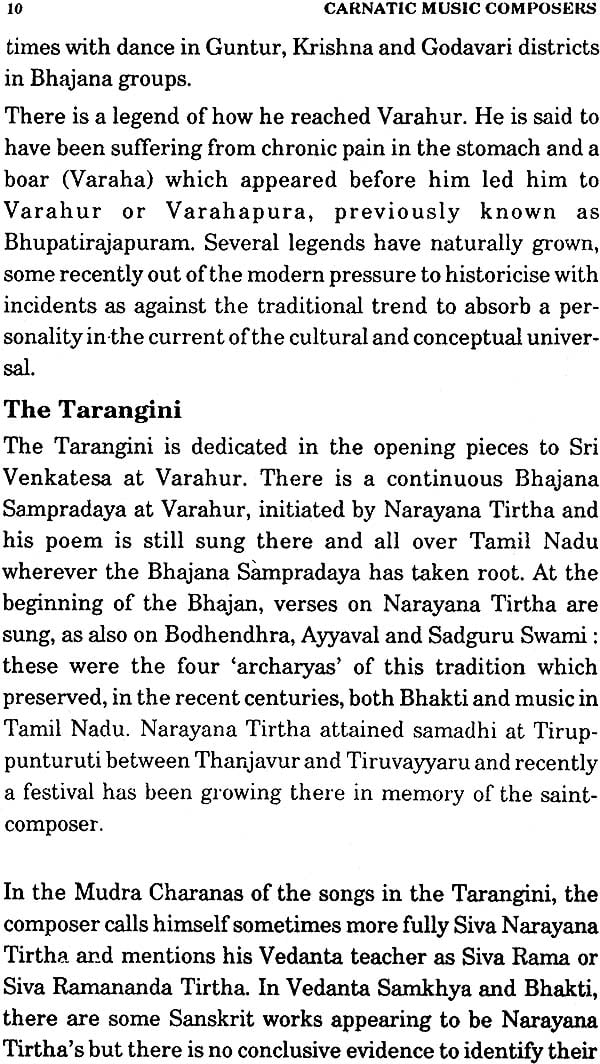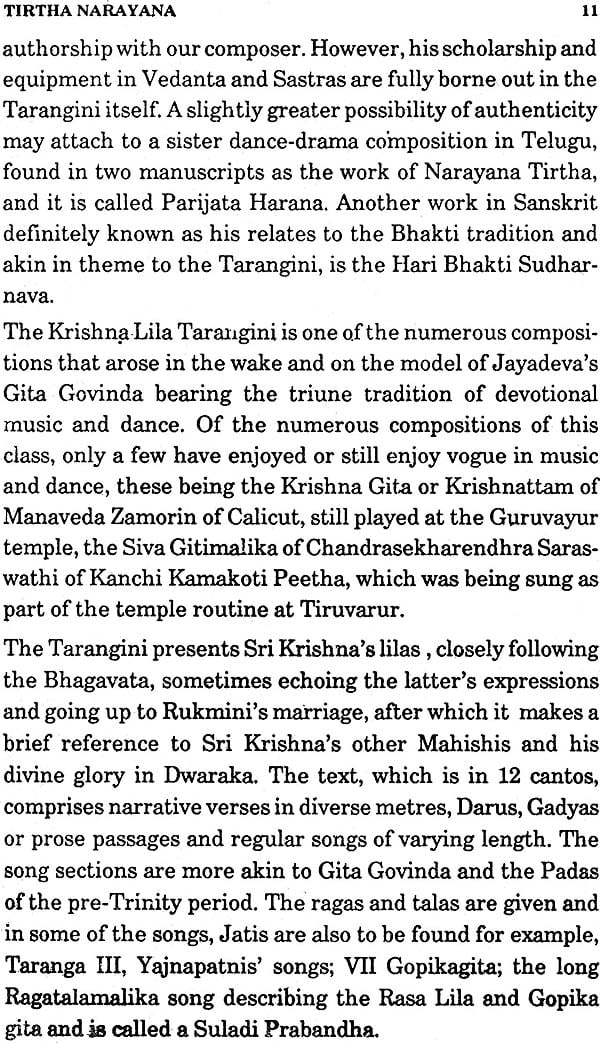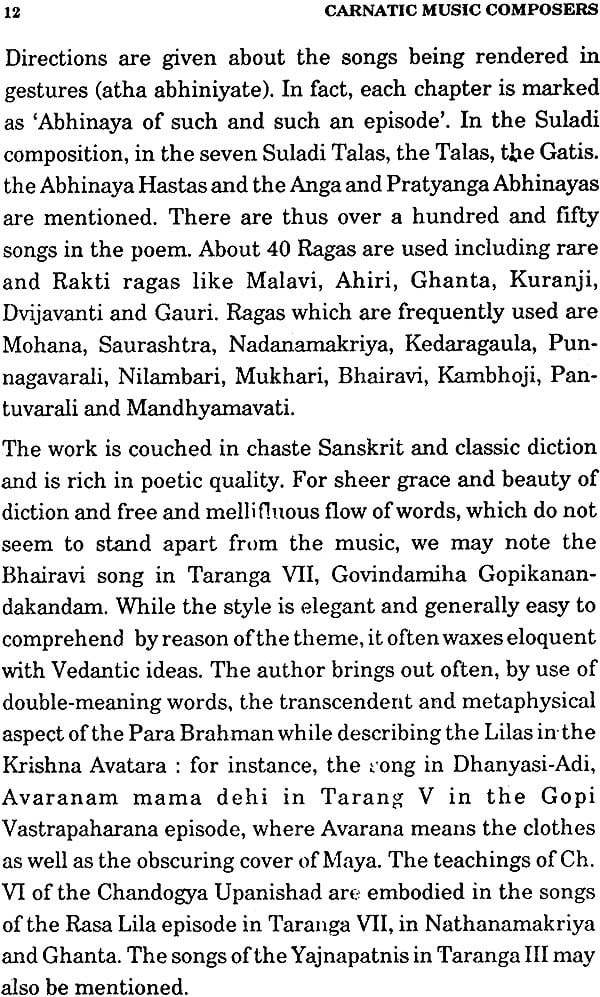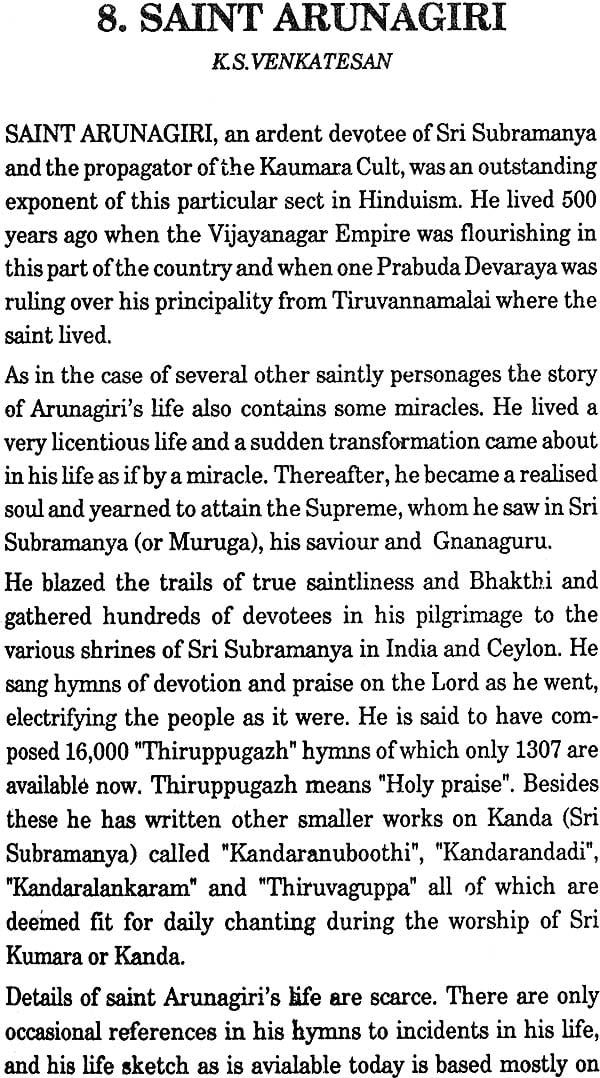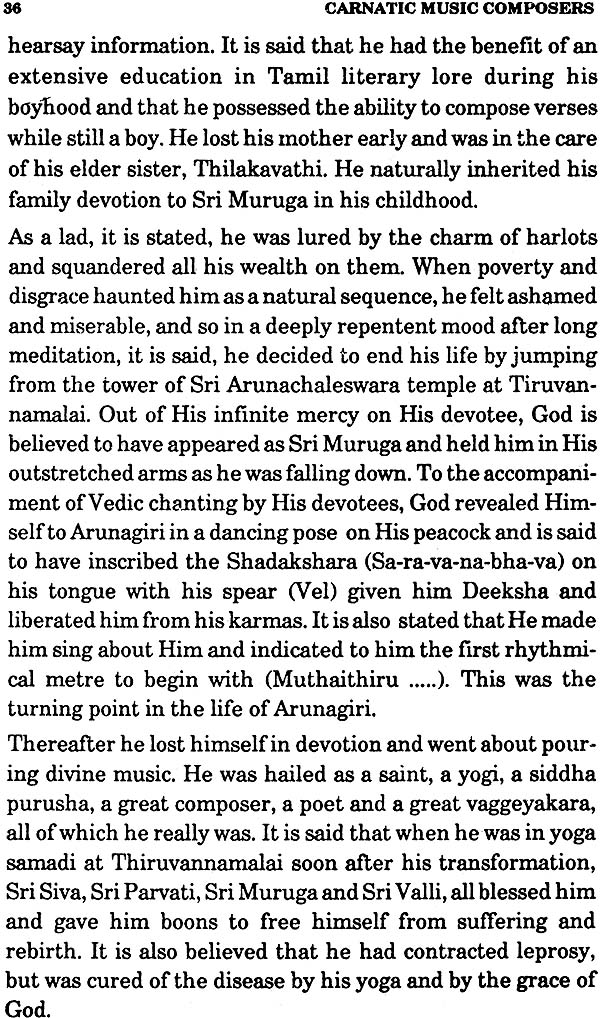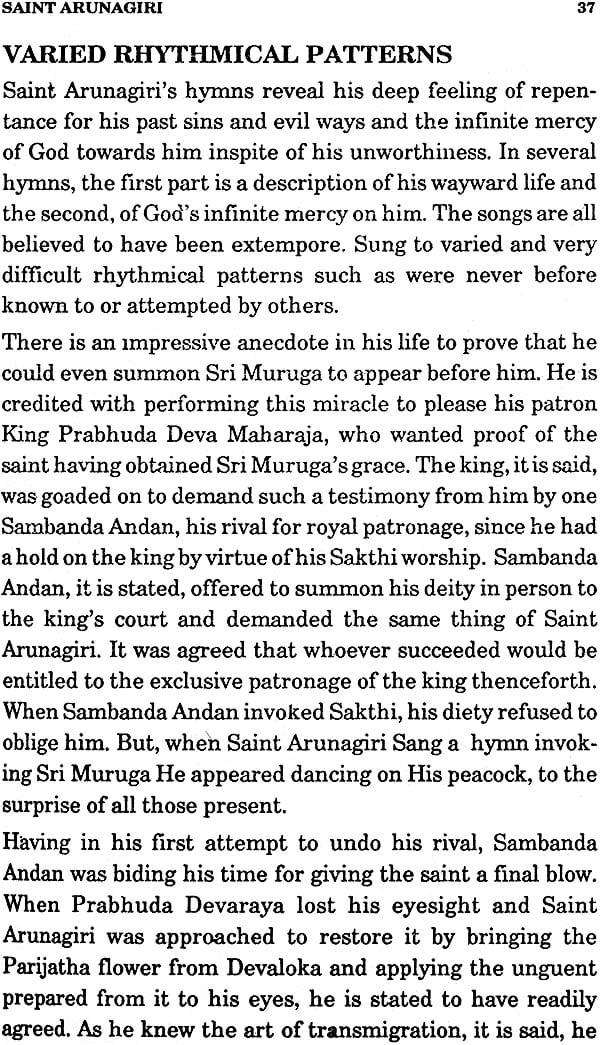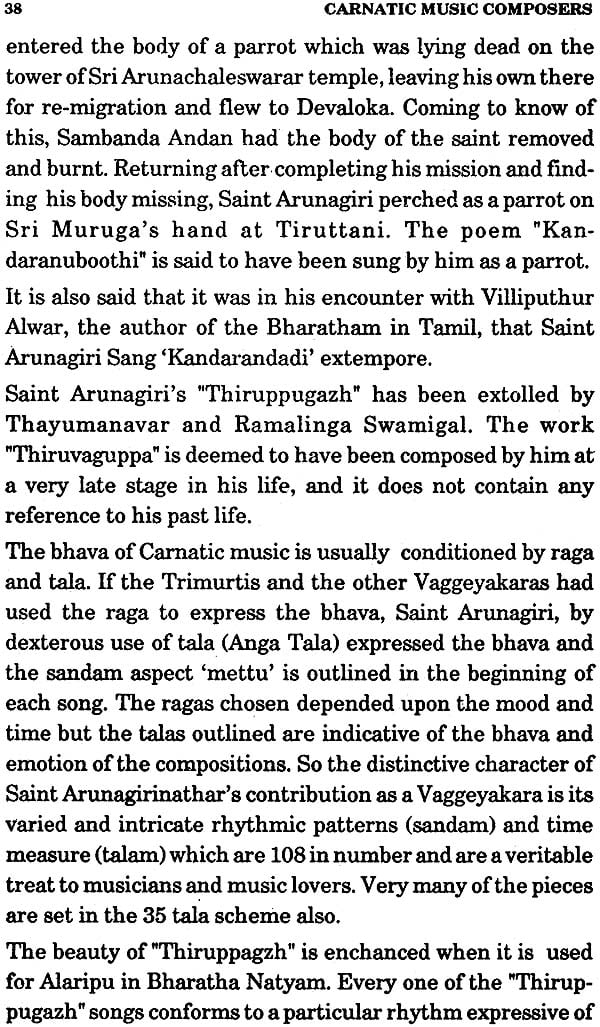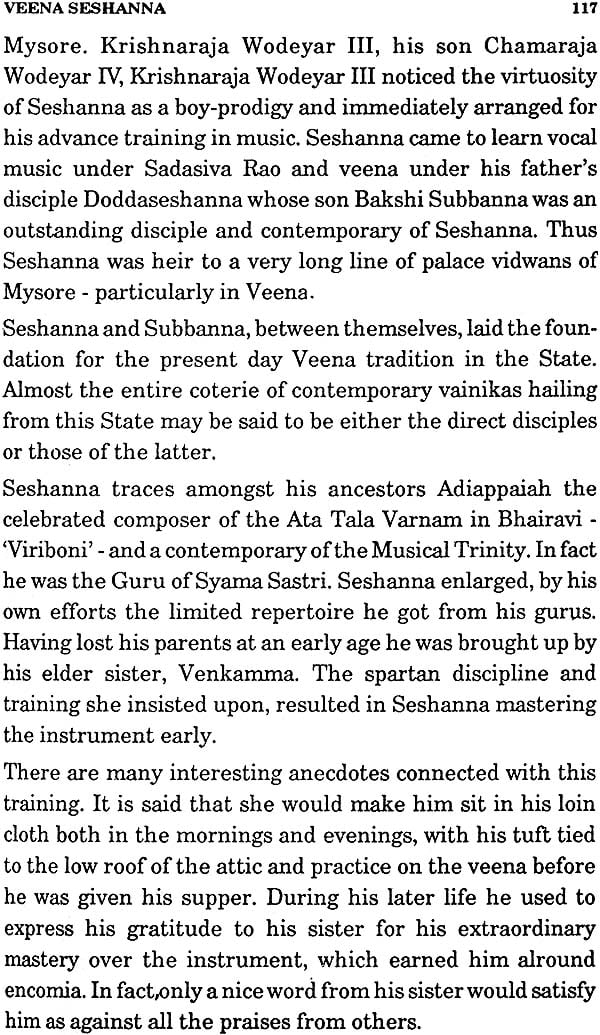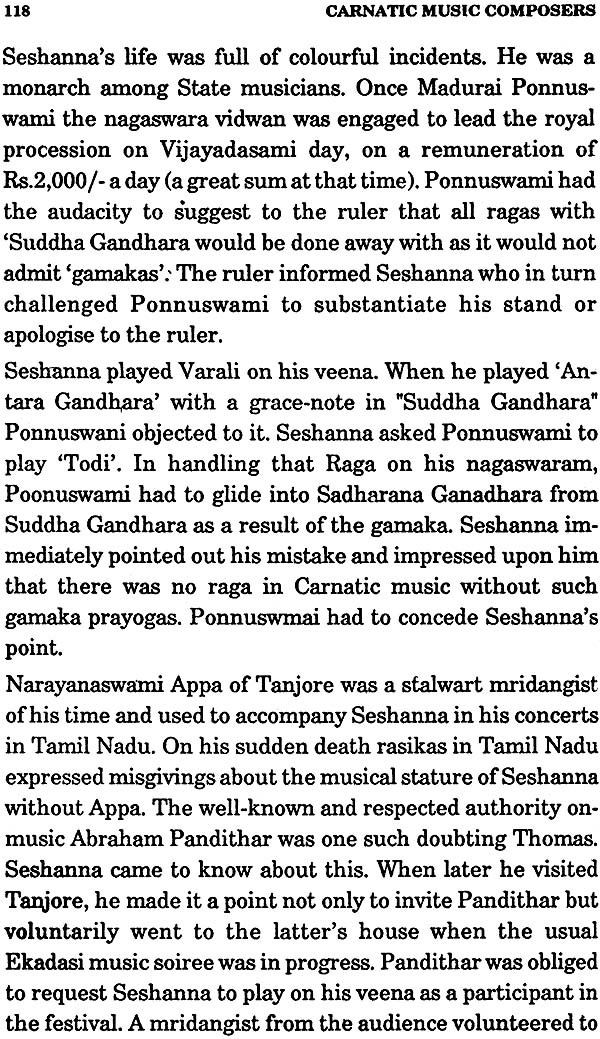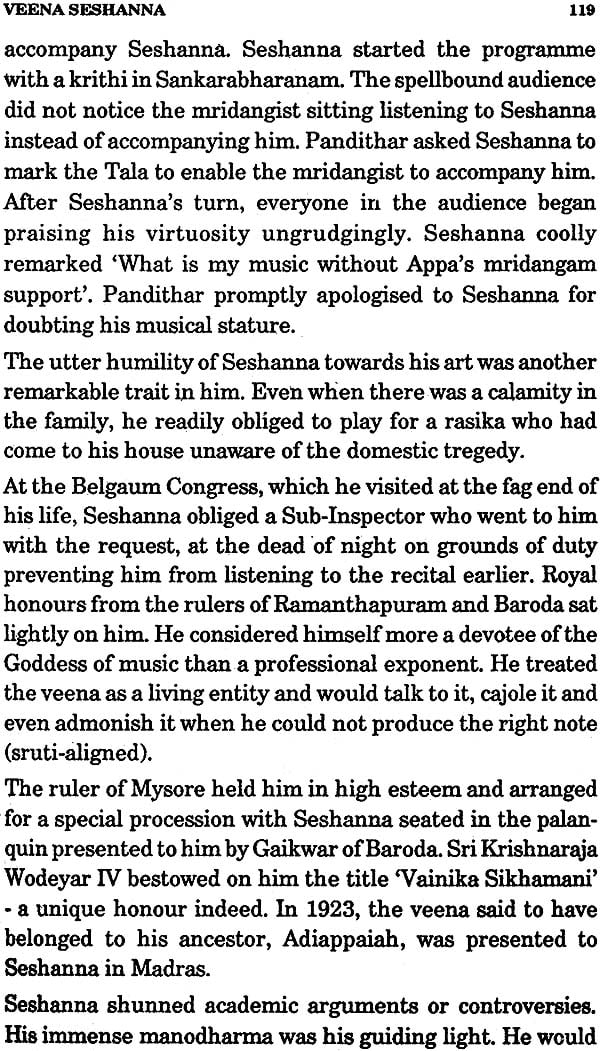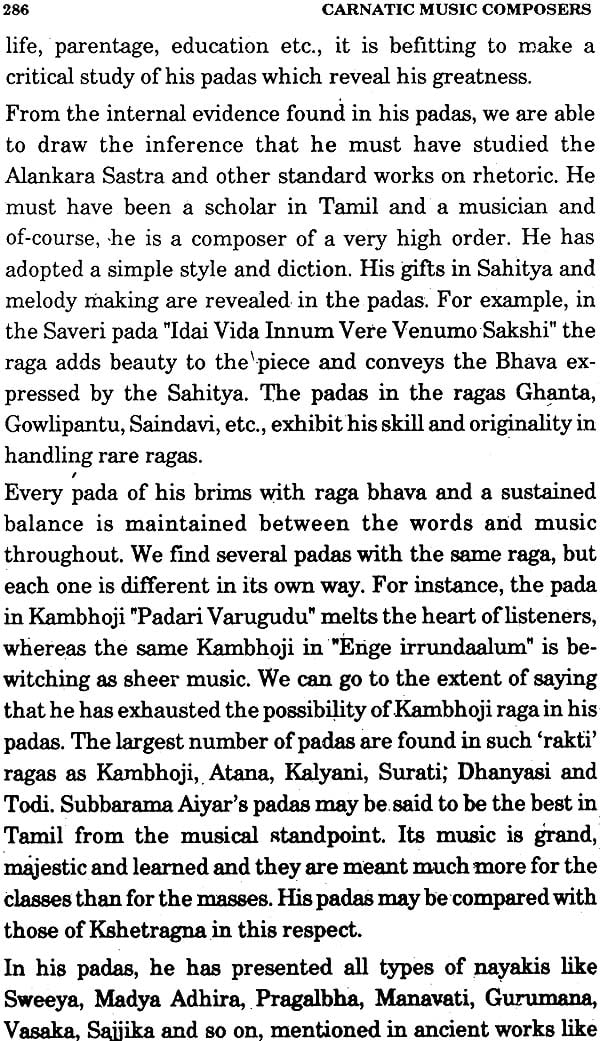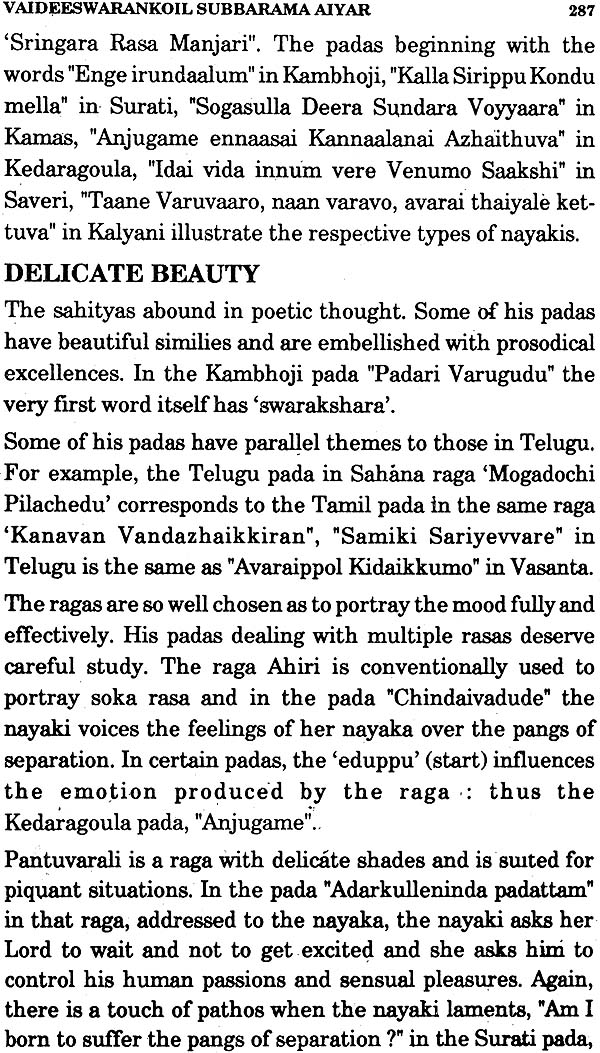
Carnatic Music Composers (A Collection of Biographical Essays) (An Old and Rare Book)
Book Specification
| Item Code: | NAL723 |
| Author: | Dr.B. Dayananda Rao |
| Publisher: | The Trinity Music Book Publishers, Chennai |
| Language: | English |
| Edition: | 2005 |
| Pages: | 558 |
| Cover: | Paperback |
| Other Details | 8.5 inch x 5.5 inch |
| Weight | 510 gm |
Book Description
"Others abide our question but like the bard of Avon Thyagaraja is free. There are, too, some half a dozen illumined souls like Bhadrachalam Ramadas and Purandara Dasa, whose story is well known in glistening detail. Several others, not so well known, have made rich contribution peripherally and at the base to the grand design that is Carnatic music. And it is the work of some of these that we propose to chronicle in this series". It is in these words that India's National Newspaper, The Hindu introduced a series of 65 biographical essays on 64 Carnatic Music Composers authored by distinguished scholars and musicologists, published one on every Sunday during the period from 21.12.1969 to 21.03.1971. The objective of the present compilation remains the same. While reproducing all the articles true to their original presentation, a few more biographical essays are included to make the work more comprehensive.
From the dawn of history, the most ardent aspirations and profoundest experiences the human spirit found their expression through the medium of art chiefly through music. The heaven-ward hankering of the soul cannot be effectively transmitted in the language of the world's commerce. Common place alphabet and jejune grammer cannot be the proper vehicle for transports of ecstasy, visions of the spirit and the deepest urges of the inward life. Art is, therefore, not an expansive superfluity or a thing of inutility but a fit medium for the expression of such emotions and experiences.
Art, of course, consists of music, dance, painting, sculpture, architecture and poetry too, all of which play an invigorating, acculturating and spiritualising role. Its main function is the expression of Beauty and the higher life of the spirit. Agonies and ecstasies of life find their lodgement in the medium of art, rhythmic movements of body, and the nuances of the eye-behaviour belong to Dance. In painting animated pigments limn forth perceived enjoyment. The lines and curves chistelled on the insensitive stone brings it to life by the self-motivated sculptor. The marvelious marble or brick and cement can create structures to match the architect's dream. Above all, the fascinating manipulation of sounds-Sapta Swaras and their rhythmic synthesis (symphony ?) will articulate the enjoyment of the musician's emotion and serve as an instrument for God-realisation. Music instructs and delights the human kind, and even gives them an occasional praise-God experience. Like the quality of mercy. it is "twice blest", it blesses the giver and the recipient.
Musicians are nearer the mystics than perhaps any other .kind of artists. The combination of music and poetry (Literature) has immense possibilities of probing the spirit and "taking the listeners on a voyage of devotional/ spiritual adventure and discovery. For example, Thyagaraja, at once a skillful word smith and an inspired musician enjoys un- challenged supremacy in the common wealth of Carnatic Music. Likewise in many great musicians, past and present, we find rapturous melody inseperably blended with the language of exquisite poetry. The collective contribution of the long line of Carnatic musicians .constitutes an invaluable treasure house of music and a significant part of India's cultural heritage.
Dr. B. Dayananda Rao, an eminent neuro-surgeon, an ardent lover and connoisseur of music, and one of the earlier Presidents of Thyagaraja Gana Sabha, Hyderabad, has done the pains-taking job of collecting the lives of Carnatic musicians as a labour of love and out of a sense of total commitment to classical music so that their assorted lives and information on their contribution to music may be available to the music loving public in book form for study and reference. In this laudable task, a mission he has undertaken, he was greatly assisted by his wife Mrs. Subhadra Rao, who is now no more.
As most of life sketches were published in 'THE HINDU' at different times, Dr. Rao, took the necessary permission to reprint them. He graciously suggested that it should be published by the TRIVENI FOUNDATION whose objectives include the promotion of Indian Renaissance with special reference to Art, Literature and, History (TRIPLE STREAM).
In view of the sad demise of Dr.Bhavaraju Narasimha Rao, TRIVENI's foster-father who ran the journal for half a century and took special interest in brining out this treatise, the mantle has fallen on me, the co-editor of the journal. On behalf of the Triveni Foundation I tender my grateful thanks to Dr. Dayananda Rao who came forward with this project in public interest.
I express the hope that discerning music lovers will extend their patronage to this useful treatise which presents the lives and contribution of the Carnatic musicians of the land.
"Others abide our question" but like .the bard of Avon, Thyagaraja is free. There, are, too, some half a dozen illumined souls like Bhadrachalam Ramadas and Puranadara Dasa, whose story is well known in glistening detail. Several others, not so well known, have made rich contribution peripherally and at the base to the grand design that is Carnatic music. And it is the work of some of them that we propose to Chronicle in this series." It is in these words that India's National newspaper, The Hindu introduced a series of 65 biographical essays on 64 Carnatic music composers authored by distinguished scholars and musicologists, published one on every Sunday during the period from 21.12.1969 to 21.3.1971. The objective of the present compilation remains the same. While reproducing all the 65 articles true to their original presentation, a few more biographical essays on the same lines are included to make the work more comprehensive.
One of the oft-repeated critical remarks about classical Carnatic music is that it is too much 'kirtana' orientated to the detriment of adequate and free 'raga' delineation. The 'sahitya' is said to interfere with melodic presentation of the 'raga'. Now if that were true, there is no need to delve into the biographical and other details about our Carnatic music composers. Hence, this criticism must be examined in some detail.
There is no doubt that real music does exist without any' 'sahitya' in any language. Or else how can we explain the reaction of the sensitive poet, John Keats, to the music of Nightingale: "Pouring forth thy soul abroad in such ecstacy." The innocent infant responds to the lullaby sung by its mother. All instrumental music, whatever be its denomination, is devoid of any meaningful 'sahitya' and yet music of the highest order is produced. Western orchestral music is built upon pure melody and rhythm. But once the composer sets the blue-print of the composition, he leaves no scope for 'mane-dharma' to the performer, 'mane-dharma' as we understand in Carnatic music. On, the other hand Hindustani classical music gives little importance to the composition or the composer. It is all 'mano-dharma' pure and simple unless one is singing a 'bhajan' or a 'thumri'. Music and its enjoyment is an inherent divine gift bestowed not only on man but also, "Sisurvetti, Pasurvetti vetti ganarasam Phani". If language is not an essential component of music in general, the question arises, what exactly is the role of 'sahitya' in music, particularly in Carnatic music?
Poet Kalidasa, a master of similie, in the very first verse of his "Raghuvamsa" kavya, campares the indivisible unity of word and its meaning to the divine unity of Parvati and Parameswara.
"Vaagardha viva sampruktau vaagartha pratipattaye
Jagatah pitarau vande parvati parameswarau".
He seeks the blessings of the divine "ardha-nareewara" so that he can find the right word with the right meaning in the right context. A word without a meaning is only a sound, even if it is extremely musical and a word with a meaning is language, may be the language of music. What the meaning is to the word, 'sahitya' is to the sound of music.
The rendering of a 'kirtana' undoubtedly enhances the aesthetic impact of a 'raga' by embellishing it with poetic and emotional overtones. We owe much to our composers, particularly the "Trinity': who have given us in their compositions exquisitely structured melodic and intensely poetic phrases full of 'raga and tala' bhava. It is truly said that while Hindustani music proceeds from note to note, Carnatic music proceeds from phrase to phrase. Each 'raga', let alone a song, has its own specific phrases which gives it an individuality. That is why a novice identifies a 'raga' using a known 'kirtana' as a model for comparision. Now to think that rendering 'kirtana' is inimical to rendering 'raga' is to say that our composers have no ear for 'raga' and a sense for 'tala', sheer blasphemy.
Let me illustrate my point with a recent experience of mine. Some time back, I was listening to a senior vidwan presenting an elaborate 'alapana' of that very charming raga 'Mohana' followed by a matter-of-fact rendering of one of the most touching of Thyagaraja's compositions, "Nanu paalimpa nadachi vachchitivo" and quickly switching on to a long- drawn 'swara kalpana' exercise. I felt that the vidwan has missed the spirit of the song and I remarked to my friend sitting next to me that Lord Rama would not walk like that even if his destination is Ayodhya. A couple of days late, I was hearing a sub-senior vidwan, (sub-senior in the parlance of the Madras Music Academy) who also elaborated the same 'raga' and sang the same 'kirtana' but atonce getting into the spirit of the song and touching the heartstrings of the listeners, if only one has a heart-to respond. The 'raga' only gained a new life and dimension with the rendering of the song. One did not feel a sense of interruption but only an enhanced impact of the 'raga' and for me, atleast, that was the very climax of the whole experience. After all Thyagaraja himself has clearly defined the relevance of 'sahitya' in his 'kirtanas'; "Nama kusumamulato poojinche nara janmame janmamu, O manasa".
The question may now arise; how do we enjoy a 'Kirtana' played on an instrument like veena or violin ? Certainly it is not entirely because of the mere notes or swaras but also our association with our previous knowledge of the song played. Therefore, the effort of all our instrumentalists in Carnatic music is to play in such a manner as to suggest the 'sahitya' clearly as close to the human voice as possible; what is termed "Gayaka Paddhati".
The question now arises; why does a composer compose music at all ? Like poetry is it all "emotion recollected in tranquility" ? If that were so, what then is the emotion that urges him to compose? As far as Carnatic music is concerned it is 'Bhakti', devotion to God, devotion in all its manifestations. That is why Thyagaraja himself coupled 'bhakti' with 'sangeeta gnanamu' in his prescription for salvation: "San- geeta gnanamu bhakti vina sanmargamu galade'.
One of the peculiar features of Sanskrit dramaturgy is that all female characters including the heroine does not speak in Sanskrit but in Pracrit while all men excluding the lowly servants speak in Sanskrit; may be an ancient version of male chauvinism. But whenever the sequence calls for an emotional response, the female characters, particularly the heroine, breaks into Sanskrit (Samscrutam asritya). Obviously, our Alankarikas thought that in an emotional con- text, the diction and language must be elevated whoever be the character. No 'bhakta' ever addressed God in bland prose when in a state of God-intoxication. They always break into soulful poetry and appealing song. Bhadrachala Ramadas, Bhakta Meera, Jayadeva and other 'bhaktas', contributed so much to our devotional music like 'bhajana'.
From an idealistic point of view, 'nara sthuthi' in any form may not be morally sustained. But it can neither be totally condemned in certain contexts. If a grateful disciple sings in praise of his 'guru' in all sincerity and devotion can one find fault with it ? 'Nara sthuthi' may pass the test of morality provided the composer is sincere and the patron deserving and the whole exercise does not degenerate into out-right flattery. Now even those composers who indulged in 'nara sthuthi' were basically 'bhaktas' addressing the majority of their compositions to their 'Ishta Daivam'. In fact 'bhakti' has been such a compelling pre-occupation in classical Carnatic music, that even apparently erotic compositions are explained away as expressions of 'madhura bhakti'.
The fact that 'bhakti' is the principal theme of Carnatic music is further exemplified if one considers the many anonymous' composers who composed beautiful songs without an eye on publicity but just for their own fulfillment. They sang them during their daily 'pooja'. They taught the songs only to their children so that the tradition is kept up.
| Forword | ||
| Preface | ||
| Acknowledgements | ||
| 1 | Subbarama Dikshitar | 1 |
| 2 | Veena Kuppayyar | 4 |
| 3 | Tirtha Narayana | 9 |
| 4 | Patnam Subrahmanya Aiyar | 15 |
| 5 | Sadasiva Brahmendra | 23 |
| 6 | Mysore Sadasiva Rao | 27 |
| 7 | Tirupati Narayana Swami Nayudu | 31 |
| 8 | Saint Arunagiri | 35 |
| 9 | Maha Vaidyanatha Aiyar | 40 |
| 10 | Poochi Srinivasa Iyengar | 47 |
| 11 | Mysore Vasudevacharya | 52 |
| 12 | Gopalakrishna Bharathi | 60 |
| 13 | Harikesanallur Muthiah Bhagavatar | 65 |
| 14 | Neelakanta Sivan | 71 |
| 15 | Tanjore Quartette | 75 |
| 16 | Last of the Tanjore Quartette | 81 |
| 17 | Pailavi Gopalayyar | 87 |
| 18 | Kotiswara Aiyar | 91 |
| 19 | Anai-Ayya | 95 |
| 20 | Annamalai Reddiar | 101 |
| 21 | Ghanam Krishna Aiyar | 105 |
| 22 | Veena Seshanna | 111 |
| 22-1 | Veena Seshanna | 116 |
| 23 | Subbaraya Sastri | 121 |
| 24 | Siddendra Yogi | 126 |
| 25 | Papanasa Mudaliar | 131 |
| 26 | Ramaswami Sivan | 135 |
| 27 | Vanamamalai Brothers | 147 |
| 28 | Karur Chinna Devudu | 153 |
| 29 | Chengalvaraya Sastri | 160 |
| 30 | Muthu Thandavar | 165 |
| 31 | Marimutha Pillai | 171 |
| 32 | Pallavi Seshayyar | 175 |
| 33 | Tiger' Varadachariar | 181 |
| 34 | K. V.Srinivasa Iyengar and Krishnamachariar | 189 |
| 35 | Kothavasal Venkatarama ~yar | 195 |
| 36 | Anmachala Kavirayar | 200 |
| 37 | Pattabhiramiah | 205 |
| 38 | Dharmapuri Subbarayar | 211 |
| 39 | Kshetragna | 216 |
| 40 | Muvvanallur Sabhapatayya | 221 |
| 41 | Sarangapani | 231 |
| 42 | Virabhadrayya | 238 |
| 43 | Melattur Venkatarama Sastri | 246 |
| 44 | Singaracharyulu Brothers | 254 |
| 45 | Kunrakkudi Krishnaier | 258 |
| 46 | Mazhavai Chidambara Bharati | 265 |
| 47 | Mayuram Viswanatha Sastri | 270 |
| 48 | Duraisami Kavirayar | 275 |
| 49 | Pallavi Duraiswami Aiyar | 278 |
| 50 | Vaideeswarankoil Subbarama Aiyar | 284 |
| 51 | Mutrubhutayya | 289 |
| 52 | Swati Tirunal Maharaja | 296 |
| 52-A | Maharaja Swati | 300 |
| Tirunal- II | ||
| 53 | Irayimman Tampi | 307 |
| 54 | Parameswara Bhagavatar | 313 |
| 55 | Paidala Gurumurthi Sastri | 319 |
| 56 | Margadarsi Sesha Iyengar | 325 |
| 57 | Toomu Narasimhadasa | 330 |
| 58 | Achyuta Dasar | 335 |
| 59 | Munipalle Subramanya Kavi | 338 |
| 60 | Venkatadri Swami | 342 |
| 61 | Lakshmana Pillai | 347 |
| 62 | Vedanayakam Pillai | 354 |
| 63 | Krishnaswami Aiyar | 359 |
| 64 | The Life and work of Papanasam Sivan | 363 |
| 65 | Narumanchi Janakiramaiah | 369 |
| 66 | Mahakavl Dasu Sriramulu | 371 |
| 67 | Sri Adibhatla Narayana Das and His works | 376 |
| 68 | Tumarada Sangameswara Sastry | 386 |
| 69 | Hari Nagabhushanam | 389 |
| 70 | Rallapalli Anantha Krishna Sarma | 393 |
| 70-A | Vaggeyakara Rallapalli Anantha Krishna Sarma | 397 |
| 71 | Vainika Praveena Subbanna | 401 |
| 72 | Veena Venkatagiriappa | 407 |
| 73 | Ogirala Veera Raghava Sarma | 413 |
| 74 | G.N.Balasubrahmanyam | 416 |
| 75 | Emani Sankara Sastri | 420 |
| 76 | Jayachamaraja Wodeyar | 425 |
| 77 | The Queen of Telugu Lallabies | 429 |
| 78 | The Coastal Muse | 432 |
| 79 | Endaro Mahanubhavulu | 440 |
| Glossaries |

